Lower Lumbar Back Pain
Lower lumbar back pain is often greatly relieved by a simple heel lift.
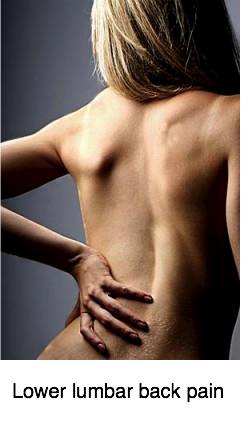
This page was last updated by Dr Barrie Lewis on 19th July, 2019.
LBP is a complex, multi factorial syndrome that causes immense suffering, early loss of independence, and inability to perform those things which bring us pleasure. Gardening becomes impossible, sitting for any length of time is uncomfortable, and a gentle amble whilst window shopping is often hopelessly miserable. A weekly game of tennis has become pie in the sky, and even sex is problematic.
The treatment of LBP is the single highest cost to the insurer after cancer and heart disease; hence raised monthly premiums for us.
Whilst our chiropractic help opinion is that we have made an enormous contribution to lower lumbar back pain, the quality of people's lives, and the cost to the insurer, it has a high risk of bias; nevertheless it's interesting that research done by two companies found that inclusion of chiropractic saved them a vast sum of money.
Nevertheless, entrenched medical interests continue to limit the payment to chiropractors despite powerful convincing independent research that manual therapy for LBP is more successful and cost effective than pills and surgery; safer too.
In the United States, many insurance schemes will remunerate for a physical therapist to give a chiropractic adjustment, but won't pay the DC.
In the Netherlands, chiropractors have to add 21 percent VAT to their bills, but physiotherapists, medical doctors and surgeons are not required to do so.
Let's not pretend that things don't go wrong with chiropractic manipulation of the lower back. The can and do; it's known as iatrogenic illness and I, like all doctors, have some of my own case files that I prefer not to remember. However, it's not common that things go seriously amiss; by that I mean life threatening.
Just the anaesthetic alone is potentially a hazard, not to mention hospital acquired infections, life threatening antiinflammatory bleeds, drug reactions and surgery induced arachnoiditis. A close family relative died at age 42 from the latter after seven lower lumbar back pain operations.
Lower Lumbar Back Pain
Lower lumbar back pain is successfully treated by means of addressing many factors like spinal subluxations, exercises and a limp from an old ankle sprain; and occasionally bed rest may be necessary.
"Each morning puts a man on trial and each evening passes judgement."
Roy L. Smith
What may make the difference is whether you said your prayers, did your back exercises and enjoyed a dish from our healthy breakfast menu, all necessary ingredients for a good day.
- Bernard Preston's Lonely Road of Faith
- Chiropractic tips for some basic low back exercises.
- Healthy breakfast menu is the only sensible way to start the day, but eat later if you want to lose weight.
L4 spine
Mrs B, a slender and tall 66 year old woman has had low back pain for as many years as she can remember. Five months before her first consult 11 months ago, a fellow player ran into her on the tennis court, and then the pain began to radiate down the side of her left thigh (an ache, 'zeurt' in Dutch), and the top of her foot making one think of L4 spine.
Walking became very difficult and painful and she had to stop tennis. She had no difficulty cycling and swimming. Prima!
The only other history of significance was a broken left ankle 11 years previously. She had no trouble in her ankle/ foot until recently.
- LEG LENGTH INEQUALITY
To find links to the topics in bold copy and paste them into the site search function in the navigation bar on your left.
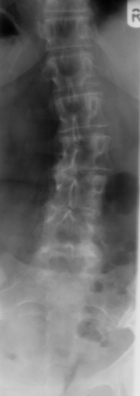
Radiologists report 2003:
Lower lumbar back pain
MEDICAL X-RAY REPORT: 2003 LWK: Een links convexe scoliose is aanwezig. Zes lumbale type wervels zijn zichtbaar. Discopathie op niveau L5-L6, mindere mate L4-L5 en L3-L4. Haakvorming spondylose m.n. L3-L4 links. Geen hoogteverlies van de corpora. Paravertebrale arthrose laag lumbaal.
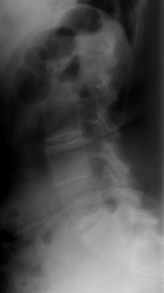
In plain English, a left convex scoliosis is present, the radiologist got it wrong. That should read right convex, but never mind, we all make mistakes now and then, and in medicine it's usually not important whether right or left, but in chiropractic it's vital. Six lumbar type vertebrae are visible. Five is the norm; this makes for unusual neurological outfall. Is it L4 spine, or L5 or L3 for that matter?
Degenerative disc disease is present at the L5 L6 joint and to a lesser extent at L4 L5 and L3 L4. Hook shaped osteophytes, spondylosis, especially at the L3 L4 joint left. No loss of height of the vertebral bodies. Facet arthrosis in the lower lumbar paravertebral joints.
To which I would add, a pelvic tilt due to a leg length inequality is seen; a short right leg.
Here's an aside of some importance. There is no mention either on the xrays, or in the report, whether these radiographs were taken erect, standing, which can lead to considerable confusion when assessing a leg length inequality.
Pain in upper leg can be a diagnostic nightmare. A short right leg. Or is it left?
ORTHOPAEDIC EXAMINATION
On examination, a moderate right-convex scoliosis was immediately evident. The global range-of-motion of the lumbar spine was remarkably good and without pain. She could touch her toes, bend backwards and sideways without pain.
The sacro-iliac tests were negative.
The sciatic stretch test, and the Slump test were both moderately positive in the posterior left leg with a mildly positive Braggards test for a strongly irritated or pinched Sciatic nerve.
Reflexes, skin sensation and muscle power were normal.
Ranges of motion of the hips was normal.
CHIROPRACTIC EXAMINATION
The pelvis was distinctly tilted, low right, the probable cause of the right-convex lumbar scoliosis. A proprioception test showed increased stability with both a 3mm and 5mm heel lift in her right shoe.
No obvious sacroiliac fixations were evident on motion palpation. L2 and L5 were markedly fixated.
No hip fixations were evident.
Examination of the left foot and ankle.
Eversion of her left ankle was distinctly limited, but not painful. Both the talar and subtalar joints were tender on palpation.
Fixations of the subtalar and cuboid joints were evident.
So, what is the chiropractic treatment of this lower lumbar back pain?
- Mrs B was simultaneously consulting a podiatrist who
prescribed a 8mm lift for her right shoe. My opinion was that 3 to 5mm
might be better. She should try 3,5 and 8 and see what her back had to
say.
- A simple basic set of lumbar exercises to be done on her bed every morning and evening.
- Side posture chiropractic adjustment of L2.
- Thompson drop protocol for adjustment of the sacroiliac joints.
- Chiropractic adjustments of the subtalar joint and, using a speeder board, the cuboid bone. Ankle rehab exercises.
- Gradually I have added more difficult exercises to her routine. Still it only takes 2 minutes every morning.
Leg length inequality
Leg length inequality, a short limb, is often crucial to the success of difficult lower lumbar back pain cases; when progress is not satisfactory, we always check for a short leg again.
Neither the 3mm lift (from me) or the 8mm lift from the podiatrist seemed to help. 8mm increased the back pain, 3mm didn't relieve it. Walking remained difficult. We continued to try different options with the heel lift, that both I and podiatrist agreed were important. Eventually we came to a compromise: he reduced the lift from 8mm to 6mm and now that helps.
Within four weeks of treatment (6 treatments) she stated that the pain in her back, leg and foot was at least 50% better. The height of the heel lift was only settled after some months of trial and error. The Slump Test improved markedly.
She had some temporary pain and discomfort after the manipulation, but that resolved within a day or two. Ice treatment helped.
It's not perfect in Mrs B's back. Of course! She has much spinal degeneration. But she can walk normally again, she's playing tennis twice a week... "het gaat goed". She's happy, it's going well. She does the exercises faithfully.
DISCUSSION of LOWER LUMBAR BACK PAIN
Mrs B had been told that she had a worn out ("versleten") back and there was nothing to be done. She must learn to live with the pain, and sadly tennis was a thing of the past.
Certainly, she has a difficult back (these X-rays were taken 8 years ago, and it's without a doubt her spine is worse now). But nothing to be done? Nonsense.
Where did the success of the case lie? Correction of her ankle complaint? The correction of her short leg? The rehab exercises? The chiropractic manipulation of her pelvis and lumbar spine?
Whilst most problems occur at the L5 or L4 lumbar spine, higher injuries occur, especially if there is an associated short leg.
RESEARCH
Only research done on 500 similar cases would answer this. One group of 100 would get only ankle treatment, another 100 only the heel lift...
Instead, the power of Chiropractic is that we address all these shortcomings and the proof of the pudding is in the eating. At 67 in a month's time and she's playing tennis again twice a week. Now that's progress!
Generally speaking, research is divided up into
- High-quality evidence
- Moderate quality evidence
- Inconclusive evidence due to a high risk of bias.
A case-report of this nature should at best be considered Incomplete evidence. I confess without reservation to the charge of being biased! And you have no idea without independent investigation whether I am lying like my feet stink! Perhaps a photograph of Mrs B on the tennis court would give this lower lumbar back pain case report more substance. You be the judge. When she gets back from her summer holiday in the south of France I'll ask whether she would mind a photograph of her on the tennis court appearing on the web!
SPONDYLOLYSTHESIS CaseFile
Spondylo-lys-thesis is a condition frequently contributing to lower lumbar back pain. One vertebra slides forwards on it's neighbour below trapping the nerve roots, and sometimes the spinal cord causing lumbar stenosis. SPONDYLOLYSTHESIS CaseFile ..
50 PERCENT LESS PAIN
Because the pain subsides faster than the tissue in your back
actually heals, 50 percent less pain is what I call the dangerous time.
Relapse is common if you're not particularly careful. 50 PERCENT LESS PAIN ..
BASIC LOWER BACK PAIN EXERCISES
Done EVERY morning before you get out of bed, it takes less than one minute, these You Tube exercises will have a profound affect on your lower back health. Whether it's L5, the sacroiliac joint or a L4 lumbar spine condition, Chiropractic Help has much to offer you. Watch the video... LOWER BACK EXERCISES. They take less than one minute.
SLUMP TEST for Sciatica
Slump test for sciatica puts increasing stress on the nerve to evaluate how badly it's been pinched.
Because the lower spine is supplied by the sciatic nerve, LOWER LUMBAR BACK PAIN should it radiate it into the leg usually follows the L5 or S1 distribution and is best tested with the Slump test for sciatica ...
The crossed sign is one of our ominous lumbar signs; if, when your doctor straightens your left leg, you get pain running down the opposite leg, then beware.
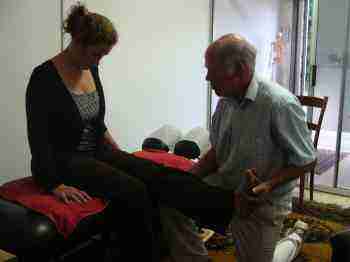
Lumbarisation and sacralizations
The norm in the lumbar spine is five vertebrae. However, not infrequently, malformations exist resulting in four or six vertebrae as in this case. There is a higher incidence of lower back and leg pain.
What makes it difficult for the chiropractor, and other professionals too presumably, is that the treatment has to personalised. One size definitely doesn't fit all, and often your chiropractor will have to try this, if it doesn't help, then that... in this casefile treatment of the pelvis alone was the key. Sacralization of L5 casefile.
Bizarre...
All of my own life I have experienced periodic lower lumbar back pain since a mishap when a ladder jackknifed my back. I do these lumbar back exercises every morning without fail, but nevertheless need a chiropractic treatment every month or two, sometimes several.
Since the last eighteen months, when I went into semiretirement, I have barely felt my back. Why? I am doing heavy work in the garden virtually every day. The more I do... the LESS back pain I experience. For example digging this hole:
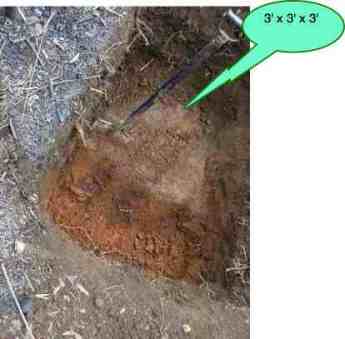
Digging a hole 1 metre wide by a 1 metre deep for an avocado tree is seriously hard work. And my back has never been better. But I do the lower back exercises EVERY morning before arising without fail.
- GROWING AVOCADO TREES
I still do my lower back exercises very faithfully every morning before getting out of bed, and I still go for an occasional but regular chiropractic adjustment.
It's the chair that does my back in... sitting. Especially in a BritRail train for some reason. The benefits of gardening is not only less back pain, it's also 22 Fuerte avocadoes twice a week. Soon the Hass will be ready. Along with the olive, perhaps the most valuable of fruits for their extremely healthy oils. Not to mention the beta-sitosterol, the cure for an ailing prostate gland. AVOCADO FAT ...

SLIPPED DISC RULES
Should you have the misfortune to have a severe slipped disc take note of these slipped disc rules ... they may just save you from the ignominy of lower back surgery.
Bed rest
Research is unequivocal: prolonged, continuous bed rest will only aggravate virtually all lower back conditions, a serious fracture excepted perhaps.
However, slipped rules include the admonition not to sit, not to stand and walk only as able. The patient in severe pain can not stand, walk or sit... so the alternative is modified bed rest. The patient lies on the back with pillows under the knees, and head and shoulders, turning as needed onto the side with a pillow between the knees.
Every half an hour, or even more frequently, the basic gentle exercises are done.
Every hour the patient shall get up for a short period, go to the toilet, and perhaps make a pot of tea... and perhaps do some perching for a short period before returning to the bed of woe.
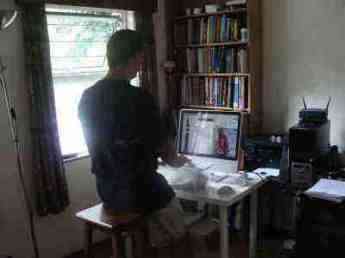
USEFUL LINKS
Did you find this page useful? Then perhaps forward it to a suffering friend. Better still, Tweet or Face Book it.
